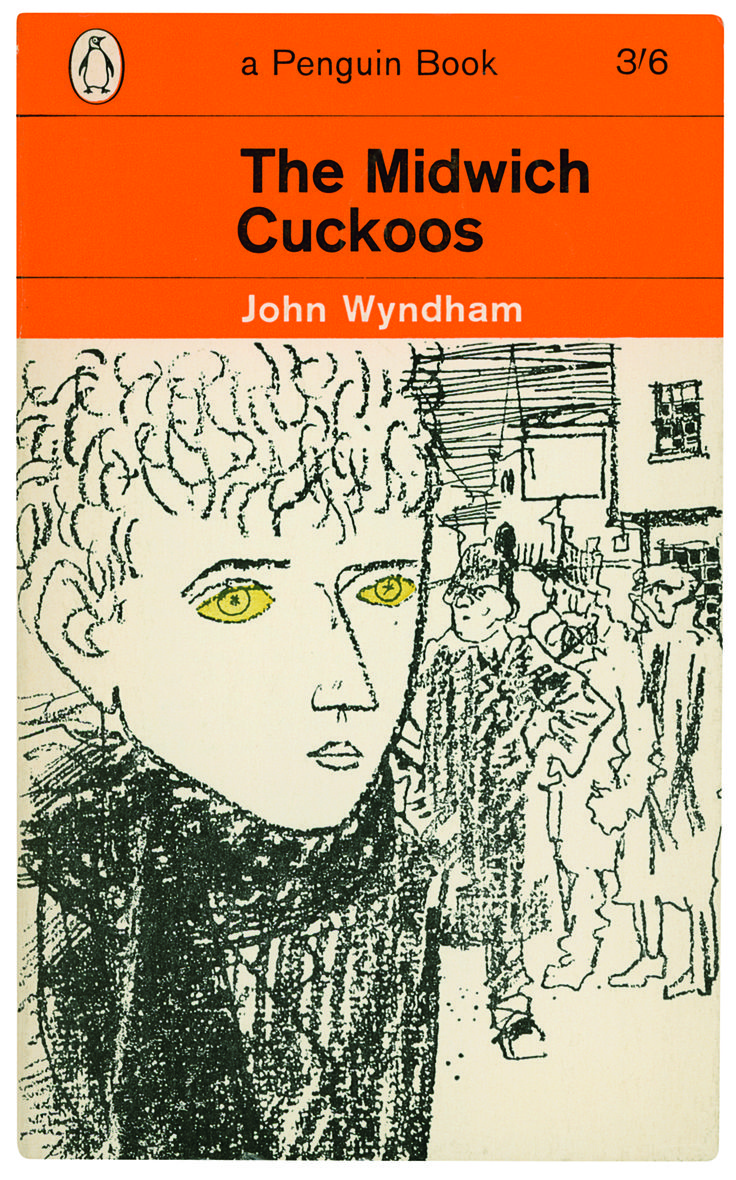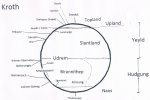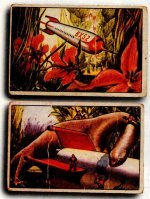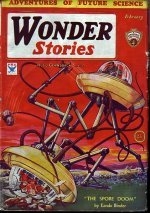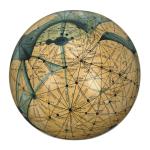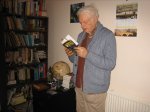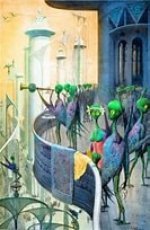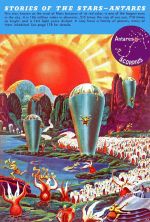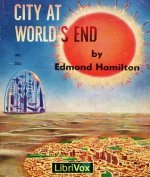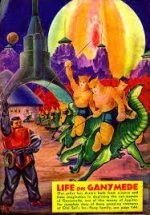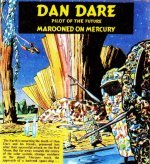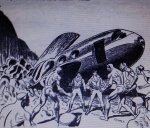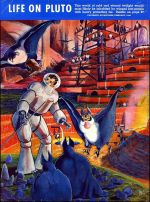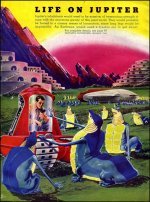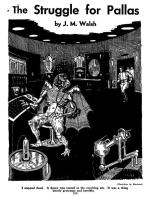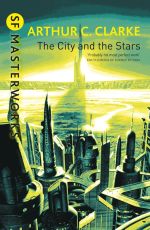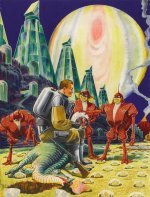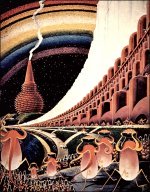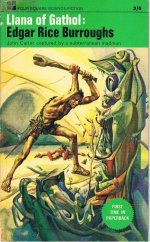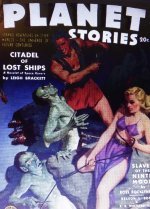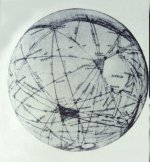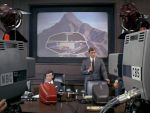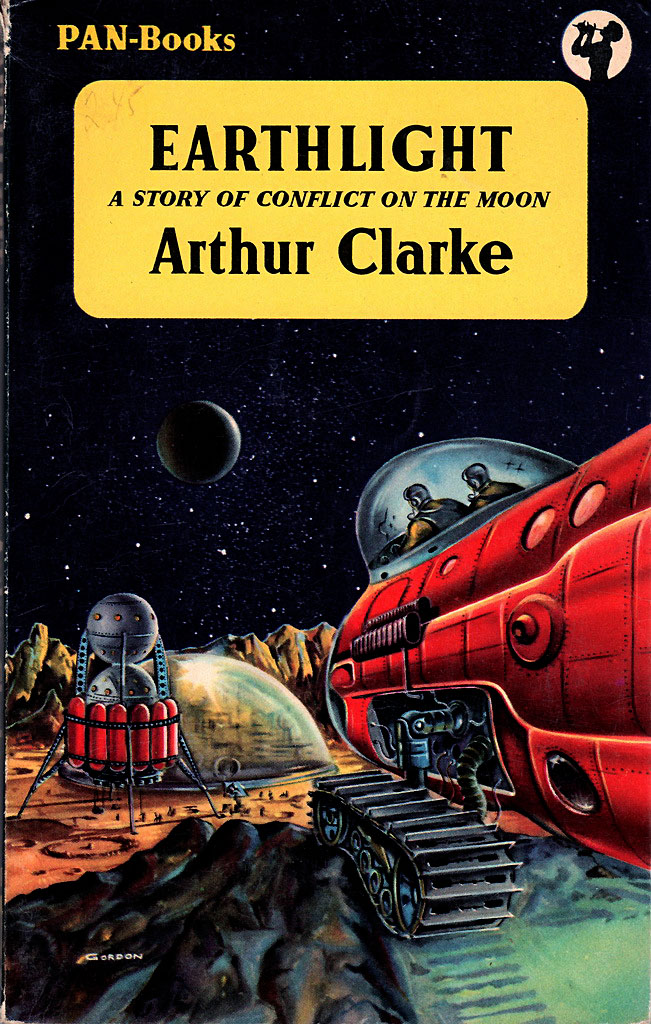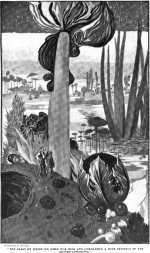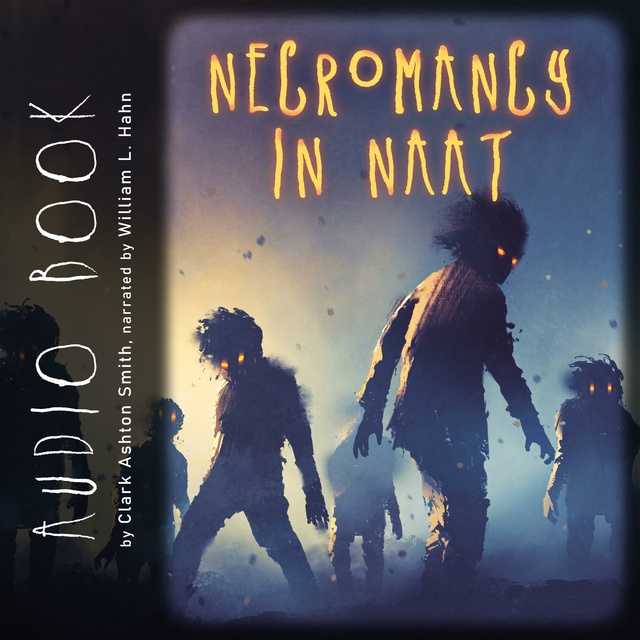a brief history of ooranye
5: the first sunnoad
[continued from 4: The Plunderers]

The Nitrogen Era, Era 7, lasted 37,759 days – or 129 Earth years. So, in duration it was one of the minor eras. But it has left a huge shadow on the collective memory of Uranian civilization.
Unfortunately we don’t know enough, as yet, to fill out our picture of the era. As with Earth’s various Dark Ages, we can get fooled by the term we’ve invented for the period. The shadows caused by our ignorance, the incompleteness of the record, can get laughably mistranslated by our imaginations into real, literal “darkness”, as though people had to grope around with flashlights during those times.
Also like Earth’s Dark Ages, the Nitrogen Era leaves us with awkward questions regarding urban life during the period. Basically, how did civilization endure? For endure it did, somehow. What finally put an end to the archaic cities of Syoom was not the perils of this transition period but – as we shall see – the mighty rebuilding which took place shortly afterwards at the beginning of Era 15.
Era 7 was “dark” because it was a time of disorder, partial chaos, wars and, most notably, that rare thing in Uranian history, demoralization.
Battles were fought over the distribution of the dwindling remains of the Sun-Egg, while, with the disbandment of the Rin-Stazel, there was no more centralized supervision of research into alternative sources of energy. Hope dwindled, and many people believed that human civilization was on the way out, that the eternal pressure of Fyaym would overwhelm Syoom. During this exceptional time there seems to have been a fading, an obscuring, of the usual awareness of the destined future. As mentioned in our previous chapter, a majority of the people even lost the faith that there would be 92 eras – their Inner Clock was in abeyance – and instead there stole upon them a sense that the Seventh Era was likely the last, and that the end was nigh.
Despair was by no means universal. People still strove. Guilds and corporations and secret societies, as well as a few of the city governments, did their best to take over where the Rin-Stazel had left off. Research became more competitive, less scrupulous. Some avenues of research, which had been shunned as repugnant and dangerous in the previous two eras, were now surreptitiously embarked upon. These included lines of inquiry into certain sinister relics left by a previous Great Cycle civilization which far pre-dated humanity. We also suspect that some organizations investigated other dimensions apart from Chelth; dubious dimensions which to us are no more than names.
And finally there may have been the emanations from the remains of Dmara. The now-dry sivvan from which humans had originated had become a sacred, shunned, deserted site. One theory goes that there must have been a fateful attempt to sample and utilise the exhalations from the basin of that vanished lake. The result: a mix of qualities, a perversion of the natural order. Think of the paradox in Earth culture which is expressed in that odd juxtaposition: ghosts (unholy) haunting churchyards (holy).
From some such source, or perhaps from some home-grown evil genius, came the dread invention known to posterity as the Corruption Ray.
This is no mere legend; it definitely existed, and on at least one later occasion was actually rediscovered, though fortunately not for long. We are ignorant as to how it worked, but the effect is certain: it was a long-range weapon, could be trained in secret upon a city by another city or fortress, and what it did can be summed up in a phrase which may raise a laugh – the weakening of moral fibre.
At first, this was traceable statistically as a drop in the level of public spirit and cultural integrity. A possible analogy with Earth history includes the cultural revolution known as the Disfigurement, which took place in Britain during the century after World War II, when the country’s constitutional, institutional, cultural, religious and moral heritage was abandoned. One symptom of this type of illness is that referents are despised. For example, by the alteration of historic boundaries and the abolition of historical weights and measures and coinage, inherited categories are subjected to “modernity” and thus shorn of character; finally, when the people have been deprived of all their roots, enemy conquest or absorption is rendered either easy or unnecessary.
The Uranians of Era 7, however, did not altogether give in to this sad process. Enough of them resisted, to make the corrupters feel unsafe. We are missing some of the details, but it seems that the “rayers” were driven out of city after city until the last and most desperate phase of the struggle, when, towards the end of the era, the Ray emanated from one hidden fortress. By this time, the users of the Ray had obtained help from non-human enemies of mankind, somewhere in Fyaym, and had become much harder to overthrow.
It may not be quite fair to characterise all users of the Ray as villains. In the early stages at least, their action may have sprung from a ruthless but partly justifiable desire to increase the tough-minded element in human society, to concentrate upon facing the energy problem and to dare to plunder the dimension of Chelth as had been planned before the disastrous end of Era 6. But by the finale of Era 7, the Corruption Ray and its users formed an unquestionable force for evil.
Terrific and heroic efforts must have been made to seek out and battle the Users and to destroy their horrendous weapon. We hope that in due course research will reveal how this was accomplished. Meanwhile, one of the things we do know about the period of that epic struggle – the last few thousand days of Era 7 – is that a certain Hyala Movoun was growing to womanhood among the crystal groves of Opahej.
The Oxygen Era
Crystal “groves” are actually small forests of crystalline plants, with so many natural defences that they are virtually immune from attack. Their proprietors are families who have, over many lifetimes, fostered a relationship of trust with their groves. Often nicknamed the Lucky Ones, these proprietors are in a position of comfort and security. A lucrative crop of excess crystals is ceded to them by the grove in return for services easily rendered such as weeding and pruning.
This independent class of people, able to withdraw deep into their groves in times of trouble, remains relatively unaffected by the political chaos and moral darkness of periods such as the Nitrogen Era. So by merely existing, the Lucky Ones have performed a service to Uranian mankind. On the debit side, they have tended to be rather selfish. Their positive contribution to history has been small. Except, that is, for Hyala Movoun.
She first became famous as a teacher. Educational systems in the Terran sense are not a feature of Uranian civilization, for Uranian children do not have to be coaxed to learn; but Uranian teachers do exist: freelancers who appear on the scene if and when they see a need for some special service which only they can perform. Hyala Movoun, as a young woman aged about 7000 days, decided that her vocation was to help restore the meanings of words which had become blunted and rendered almost useless by the blight of cynicism caused by the Corruption Ray.
Accordingly she perfected certain mental exercises, and then set herself up as a tutor – a sophist, our ancient Greeks would have called her – to advise those in positions of influence in her adopted city of Narar. Her success was so astonishing and so widespread that she was soon moved to a more influential cultural hub: Contahl, then still the most powerful city on Ooranye. From there, her message of verbal purity swept through Syoom like flame through straw. Part of the explanation must lie in her own exceptional nature, and part in the fact that this was what the world was desperately waiting for: someone to wean it from sniggering, from flippancy, from the whole miasma left in the air by the events of recent times. The effect of her teaching built up quickly to the point at which the general public emotion affected the rhythm of daylight, and this eomasp marked a change from the Nitrogen to the Oxygen Era.
Era 8 lasted a mere forty heady days of pan-Syoomean revival. Hyala Movoun was invited to make her home and office in the central north-polar city of Skyyon. Here she practically took the government of Syoom into her hands. She agreed to the move to Skyyon – geographically it is central – but when asked literally to govern Syoom, her answer was neither a straight yes nor a straight no. No single individual has ever ruled Syoom, and she went on record as saying that it could not be done. On the other hand she did see the need for some international focus, some living symbol to whom the cities of nennkind could give their allegiance in matters of common interest and common principle. In short, she recognized the need for a Noad of Noads; and she became the first one in history – the first individual to bear a number after nen’s name: Hyala Movoun 1.
Her investiture as Sunnoad and the festivities associated with it caused another heightened, etheric wave of emotion: the 22 hours known to history as the Fluorine Era. Then came the era which can be called the Reign of Hyala Movoun.
The Neon Era
Lasting 5,558 Uranian days or 19 Earth years, the Neon Era is short but naturally crammed with legends, some believable and some not, centred around the personality and exploits of the First Sunnoad. A few critics have tried to find fault with her, but it has not been easy. Obviously her charisma must have inspired such a combination of awe and affection that problems which would have baffled other statesmen simply dissolved before her glance. Yet this reliance on individual greatness has been cited as a defect of the regime, for what happens when the individual who sustains it is no more?
Another criticism is that Hyala as time went by began to rely too much on her own past record; in other words, it could be said that she became lazy, or at any rate naïve, believing that her influence, her beauty and kindness and lremd intuition, would suffice to solve every problem.
A few people voiced these doubts at the time. Historians will argue forever as to whether they were justified. What is certain, is that Hyala came to agree that a Sunnoad must submit occasionally to freelance Correction – provided that the Corrector was willing to put nen’s life on the line.
The institute of Correction, therefore, is almost as old as the sunnoadex: the first Corrector, Lehal Thoal, corrected the first Sunnoad, Hyala Movoun.
The occasion was close to the end of the Neon Era. The issue was, yet again, the energy crisis. The crisis had become muted for a while: the very depths to which society had sunk during the Nitrogen Era had lessened people’s demands for energy, and then during the Neon Era humanity had lived on gratitude and euphoria. Yet the situation was obviously not stable. Hyala Movoun could not allow herself to forget that the problem had merely been shelved. Soon, when the power ran out, any concerted threat from Fyaym would find Syoom unable to defend itself.
Be it noted that the gentle, charming, beautiful Hyala Movoun made the ruthless decision to renew the project of the Rin-Stazel to plunder the dimension of Chelth. She saw no other way to obtain for her people the power-source they needed. Tapping the last dregs of the Sun-Egg, the great Project was revived. Since the records have been hidden or destroyed, we do not know how it was done, and it is doubtless best (though of course frustrating for the historian) that we do not know.
What we do know is that towards the end, Hyala Movoun had doubts about this trans-dimensional solution to the energy crisis. She found out something – we are not sure what – which made her try to delay or even halt the Project. This is where Lehal Thoal took the action which might have resulted in his execution. He coerced the Sunnoad. In fact he kidnapped her and kept her hostage for three days. This breathtaking boldness was rewarded with success: he managed to persuade the Noad of Noads to rescind her order and let the Project go ahead. Then he released her. She – with a genius for turning defeat into victory – proptly created an institution and a tradition out of what had happened, proclaiming Lehal Thoal the first Corrector.
These events, dramatic though they were, are overshadowed by the universe-shaking epic which followed. The next four eras lasted a very short time in total, but it is fair to say that no other period has had such an impact upon Uranian history.
Before we go into that, let us mention one lasting achievement of the era with regard to everyday life: the invention of the skimmer, the vehicle which ever since has been used more than any other for individual personal transport on Ooranye. The skimmer’s design grew out of that of the Lithium Era hover-raft. A skimmer is lighter, more streamlined and much swifter. Mounted on these low-flying canoe-shaped craft, Uranian wayfarers feel most in their element as they roam free across the plains of the giant planet. Legends grew up around the pioneer skimmer-pilots of the Neon Era, though the vehicles were not mass-produced or available to all who wanted them until the Phosphorus.
Chelth
It proved impossible to keep the plunder of Chelth a secret. As soon as the source was tapped, as soon as power began its massive flow from Chelth into our universe – into receptacles in the Vaults of Skyyon on Ooranye – such a disturbance arose in the air, as to make everyone aware that a new era had begun. The need for secrecy was, however, universally understood. Secrecy not with regard to Uranians, but with regard to the inhabitants, if any, of Chelth. For it was feared that other things besides power might flow along the trans-dimensional link from there to here. Condemnation, punishment! The people of Syoom had to assume the worst. So they made a supreme effort to quieten their thoughts, to say “Sh…” with their minds. As far as possible, they disciplined themselves to focus away from the subject which was otherwise uppermost in all their thoughts.
For 130 days and 6 hours (the Sodium Era) this discipline held firm. The tapping of energy continued, the energy-vats in Skyyon and other cities grew fuller, the enterprise went ahead successfully. Then came what became known in history and folklore as the “flare of arrest”.
It lasted 58 minutes, and has counted in history as the Magnesium Era. No one who lived through it ever described it scientifically. Poets and storytellers have likened it to a sense of being tapped on the shoulder. Scientists generally assume that the mental effect was caused by something real, namely the action of a Chelthan entity who had become aware of what our universe was doing to his.
Then came the last great act of Hyala Movoun. At least, it is supposed that the action was hers. It is unlikely that anyone else could have done it – could have made a mental bargain with the forces from Chelth, could have found an ally there who was willing to offer the bargain: “halt the Project now, destroy its records, and we will allow you to keep what you have gained so far; provided that you also give us… yourself.” This deal was struck during the 2 hours and 43 minutes of the Aluminium Era, while the world held its collective breath.
The deed was done, and a strange peace fell over the land of Syoom. It was a quietness of sorrow and triumph: the one day and 26 hours of the Silicon Era, during which millions of inhabitants of Uranian cities dithered aimlessly, shuffling about as they waited for Hyala Movoun to die. Her people’s awareness tripped, stubbed against a parcel they found dumped in their minds: the idea that Hyala’s soul was about to be carried off to Chelth. There she’d be pinned, experimented on by her adversaries. Outrageous, unbearable thought. But, on the other hand, too large to protest. People trusted, or hoped, that the Chelthan bargainer would spare her torment, but anyhow there was nothing to be done. Everyone was quietly aware of the score.
Then,
abruptly, the ‘tap’ was turned off, the ‘cable’ cut, the link severed between Chelth
and our universe. Insights faded like a dream.
Many notes survive – those that were written contemporaneously; but later
memoirs are few, and the official records were destroyed as part of the
bargain, so we need not be surprised that data concerning the Plundering mostly
failed to outlast the hours of the Sodium Era.
